-
Paper Information
- Next Paper
- Previous Paper
- Paper Submission
-
Journal Information
- About This Journal
- Editorial Board
- Current Issue
- Archive
- Author Guidelines
- Contact Us
American Journal of Chemistry
p-ISSN: 2165-8749 e-ISSN: 2165-8781
2012; 2(6): 335-342
doi: 10.5923/j.chemistry.20120206.07
Kinetic, Equilibrium and Thermodynamic Studies of the Biosorption of Heay Metals by Ceratonia Siliqua Bark
Ahlam M. Farhan1, Nidá M. Salem2, Ahmad L. Ahmad2, Akl M. Awwad3
1Department of Chemistry, Faculty of Science for Women, Baghdad University, Baghdad, Iraq
2Department of Plant Protection, Faculty of Agriculture, Jordan University, Amman, Jordan
3Department of Knowledge, Royal Scientific Society, El Hassan Science City, Amman, Jordan
Correspondence to: Akl M. Awwad, Department of Knowledge, Royal Scientific Society, El Hassan Science City, Amman, Jordan.
| Email: |  |
Copyright © 2012 Scientific & Academic Publishing. All Rights Reserved.
Biosorption of Zn(II), Ni(II), Cu(II) and Cd(II) ions from aqueous solutions onto Ceratonia siliqua (Carob tree) bark has been investigated in a batch biosorption process. The biosorption process was found to be dependent on pH of solution, initial metal ion concentration, biosorbent dose, contact time and temperature. The experimental equilibrium biosorption data were analyzed by Langmuir, Freundlich, Temkin and Dubinin-Radushkevic isotherm models. The Langmuir model gave a better fit than the other three models by higher correlation coefficient, R2. The maximum biosorption capacity calculated from the Langmuir isotherm was 42.19 mg/g, 31.35 mg/g, 21.65 mg/g and 14.27 mg/g for Ni(II), Zn(II), Cu(II) and Cd(II), respectively at optimum conditions. The kinetic studies indicated that the biosorption process of the metal ions followed well pseudo-second-order model. The negative values of ∆Go and the positive ∆Ho revealed that the biosorption process was spontaneous and endothermic. According to the biosorption capacity, Ceratonia siliqua bark considered as an effective, low cost, and environmentally friendly biosorbent for the removal of metal ions ions from aqueous solutions.
Keywords: Biosorption, Ceratonia siliqua bark, Ni(II), Zn(II), Cd(II), Cu(II), Kinetic, Thermodynamic
Cite this paper: Ahlam M. Farhan, Nidá M. Salem, Ahmad L. Ahmad, Akl M. Awwad, "Kinetic, Equilibrium and Thermodynamic Studies of the Biosorption of Heay Metals by Ceratonia Siliqua Bark", American Journal of Chemistry, Vol. 2 No. 6, 2012, pp. 335-342. doi: 10.5923/j.chemistry.20120206.07.
Article Outline
1. Introduction
- The major sources of Ni(II), Zn(II), Cu(II) and Cd(II) ions release into the environment by waste streams are electroplating, leather tanning, paint dyes and textiles industries. Different methods of treating effluents containing metals have been developed over years which include chemical precipitation, chemical oxidation or reduction, electrochemical treatment, ion exchange, reverse osmosis, filtration, evaporation recovery, adsorption, and electrocoagulation[1-8]. These methods have significant disadvantages, including high energy requirements, incomplete metal removal, generation toxic sludge needs treatment and expensive equipments. The search for novel technologies has recently been directed to the application of biosorption, which constitutes an attractive to common applied physical-chemical methods. The advantages of biosorption lie in the good performance in metal removal, cost-effectiveness and eco-friendly to environment. Many biomaterials have been investigated as biosorbents for removal of heavy metals such as leaf, stem and root phytomass of Quercus ilex[9], pomegranate peel[10], banana (Musa paradisiaca), lemon (Citrus limonum) and orange (Citrus sinensis) peel[11], rice husk[12], peanut husk[13], neem leaf[14], hazelnut, walnut and almond shell [15], Ulmus carinifolia and Fraxinus excelsior leaves[16], processed walnut shell[17], sugar cane bagasse[18], walnut, hazelnut, almond, pistachio and apricot stone[19], Lagenaria vulgaris shell[20], olive leaves[21], Eriobotrya japonica[22], grape stalk waste[23], Pinus sylvestriis[24], Eucalyptus bark saw dust, mango bark saw dust, and pineapple fruit peel[25]. ceratonia siliqua tree is native to the Mediterranean region and grows up to 10 meters tall. Its crown is broad and semi-spherical, supported by a thick trunk with brown rough bark. The present study describes a new biosorbent Ceratonia siliqua bark (carob bark) for the biosorption of Ni(II), Zn(II), Cu(II) and Cd(II) ions from aqueous solutions. The effects of different parameters such as the pH of the solution, the initial metal concentration, the dose of the absorbent, the contact time and temperature were investigated.
2. Materials and Methods
2.1. Adsorbent
- Ceratonia siliqua bark was collected from a local carob trees at Royal Scientific Society Campus, Amman, Jordan. C. siliqua bark was thoroughly rinsed with distilled water to remove dust and soluble materials and then it was allowed to dry at room temperature. The dried C. siliqua was crushed and grounded to a fine powder in a grinding mill (Retsch RM 100) and sieved to get size fraction < 44 µm. The C. siliqua bark powder was dried in an oven at 60℃ for 6 h and then stored in a desiccator to be used for the batch experiments.
2.2. Materials
- All chemicals used were analytical grade purchased from Fluka AG. Stock solutions of 1000 mg/L were prepared by dissolving NiSO4.6H2O, ZnSO4.7H2O, Cu(NO3)2.5H2O and Cd(NO3)2 in distilled deionized water. Desired test solutions of metal ions were prepared using appropriate subsequent dilutions of the stock solutions. The range of concentrations of metal ions prepared from standard solution varies between 5 and 100 mg/L. Before mixing the adsorbent, the pH of each test solution was adjusted to the required value with 0.1 M NaOH or 0.1 M HCl.
2.3. Analysis
- The concentrations of metal ions in the solutions before and after equilibrium were determined by atomic absorption spectrometer (AAS-6300, Shimadzu, Japan). The pH of the solution was measured with a WTW pH meter using a combined glass electrode. Fourier transform infrared spectroscopy, FT-IR (IR Prestige-21, Shimadzu, Japan) was used to identify the different chemical functional groups present in C. siliqua bark. FT-IR analysis also used to determine the functional groups which are responsible for the metal binding with C. siliqua bark. The analysis was carried out using KBr and the spectral range varying from 4000 to 400 cm−1.
2.4. Batch Biosorption Experiments
- Batch biosorption experiments were conducted by mixing biosorbent with metal ion solution with desired concentration in 250 mL glass flask. The glass flasks were stoppered during the equilibration period and placed on a temperature controlled shaker at a speed 120 r/min. The effect of pH on the equilibrium biosorption of Ni(II), Zn(II), Cu(II) and Cd(II) was investigated by mixing, The amount of biosorption was calculated based on the difference between the initial (Co, mg/L) and final concentration (Ce, mg/L) in every flask, as follows:
 | (1) |
 | (2) |
3. Results and Discussion
3.1. Effect of pH
- The effect of pH on the biosorption of metal ions onto C. siliqua bark was studied at pH 1.0–8.0. The maximum biosorption was observed at pH 5.0-6.0 for metal ions. Therefore, the remaining all biosorption experiments were carried out at this pH values.
3.2. Effect of Initial Metal Concentration
- Ni(II), Zn(II), Cu(II) and Cd(II) ions biosorption by C. siliqua bark was studied in batch experiments (pH 5.0-6.0) using different initial metal concentrations of 5, 20, 40, 60, 80 and 100 mg/L. The equilibrium uptake of the biosorbent was observed increasing gradually with an increasing the initial concentration of metal ions. The increase of biosorption yield with the increase in metal ions concentration is probably due to higher interaction between the metal ions and sequestering sites of biosorbent
3.3. Effect of Contact Time
- The rate of biosorption is important for designing batch biosorption experiments. Therefore, the effect of contact time on the biosorption of metal was investigated. The biosorption of Ni(II), Zn(II), Cu(II) and Cd(II) ions increased considerably until the contact time reached 80 min at 30℃. Further increase in contact time did not enhance the biosorption, so, the optimum contact time was selected as 80 min for further experiments.
3.4. Effect of Adsorbent Dose on Biosorption
- The biosorbent dosage is an important parameter because this determines the capacity of a biosorbent for a given initial metal concentration. The biosorption efficiency for Ni(II), Zn(II), Cu(II) and Cd(II) ions as a function of biosorbent dosage was investigated. The percentage of the metal biosorption steeply increases with the biosorbent loading up to 5 g/L. This result can be explained by the fact that the biosorption sites remain unsaturated during the biosorption reaction whereas the number of sites available for biosorption site increases by increasing the biosorbent dose. The maximum biosorption for Ni(II), ZN(II), Cu(II) and Cd(II) was attained at biosorbent dosage, 5 g/L. Therefore, the optimum biosorbent dosage was taken as 5 g/L for further experiments.
3.5. Biosorption Isotherms
- An adsorption isotherm describes the fraction of sorbate molecules that are partitioned between liquid and solid phases at equilibrium. Biosorption of Ni(II), Zn(II), Cu(II) and Cd(II) ions onto C. siliqua bark powder was modeled using four adsorption isotherms.The Langmuir isotherm assumes monolayer adsorption on a uniform surface with a finite number of adsorption sites. Once a site is filled, no further sorption can take place at that site. As such the surface will eventually reach a saturation point where the maximum adsorption of the surface will be achieved. The linear form of the Langmuir isotherm model is described as[26]:
 | (3) |
 | (4) |
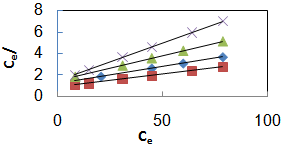 | Figure 1. Langmuir isotherm for , Ni(II); , Ni(II);  , Zn(II); , Zn(II);  , Cu(II); X, Cd(II) ions biosorption onto C. siliqua bark , Cu(II); X, Cd(II) ions biosorption onto C. siliqua bark |
 | (5) |
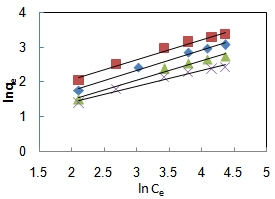 | Figure 2. Freundlich isotherm for  , Ni(II); , Ni(II);  , Zn(II); , Zn(II);  ,Cu(II); X, Cd(II) ions biosorption onto C. siliqua bark ,Cu(II); X, Cd(II) ions biosorption onto C. siliqua bark |
 | (6) |
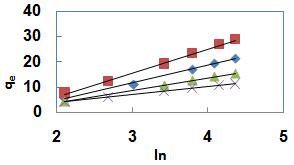 | Figure 3. Temkin isotherm for  , Ni(II); , Ni(II);  , Zn(II); , Zn(II);  , Cu(II); X, Cd(II) ions biosorption onto C. siliqua bark , Cu(II); X, Cd(II) ions biosorption onto C. siliqua bark |
 | (7) |
 | (8) |
 | (9) |
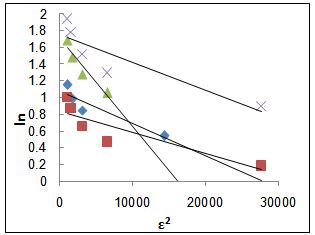 | Figure 4. D-R isotherm for  , Ni(II); , Ni(II);  , Zn(II); , Zn(II);  , Cu(II); X, Cd(II) ions biosorption onto C. siliqua bark , Cu(II); X, Cd(II) ions biosorption onto C. siliqua bark |
3.6. Biosorption Kinetics
- Parameters from two kinetic models, pseudo first-order and pseudo second-order were fit to experimental data to examine the biosorption kinetics of metal uptake onto C. siliqua bark. The pseudo-first order equation of Lagergren [30] is generally expressed as follows:
 | (10) |
 | (11) |
 | Figure 5. Pseudo-first order kinetics for  , Ni(II); , Ni(II);  , Zn(II); , Zn(II);  , Cu(II; x, Cd(II) biosorption onto C. siliqua bark , Cu(II; x, Cd(II) biosorption onto C. siliqua bark |
 | (12) |
 | (13) |
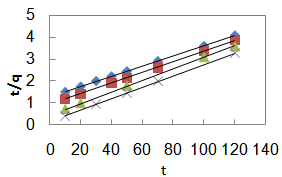 | Figure 6. Pseudo-second order kinetics for  , Ni(II), , Ni(II),  , Zn(II), , Zn(II),  ,Cu(II), X, Cd(II) ions biosorption onto C. siliqua bark ,Cu(II), X, Cd(II) ions biosorption onto C. siliqua bark |
|
3.7. Thermodynamic Parameters
- In order to describe thermodynamic behaviour of the biosorption of metal ions onto C. siliqua bark, thermodynamic parameters including the change in free energy (∆G◦), enthalpy (∆H◦) and entropy (∆S◦) were calculated from following equations[31,32]:
 | (14) |
 | (15) |
 | (16) |
 | (17) |
 | (18) |
3.8. FT-IR Spectroscopy Analysis
- FT-IR spectra of C. siliqua bark biosorbent, Figure 7 showed a number of absorption peaks reflecting its complex nature. A strong band at 3340 cm-1 results due to the stretching of the N-H bond of amino groups and also indicative of bonded hydroxyl groups O-H. The bands at 2916 cm-1 and 2846 cm-1 could be assigned to –CH stretching vibrations of –CH3 and –CH2 functional groups. The peak at 1612 cm-1 is due to C=O stretching mode of the primary and secondary amides. The bands at 1134 cm-1 to 1473 cm-1 are indicative of the N-H stretching of the primary and secondary amides and the presence of carboxylic acids. The strong band of C-O at 1026 cm-1 confirms the lignin structure of C. siliqua bark.
|
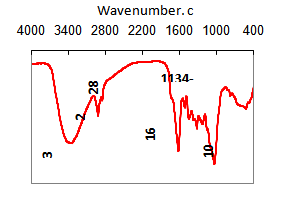 | Figure 7. FT-IR of spectra of C. siliqua bark before biosorption of metals |
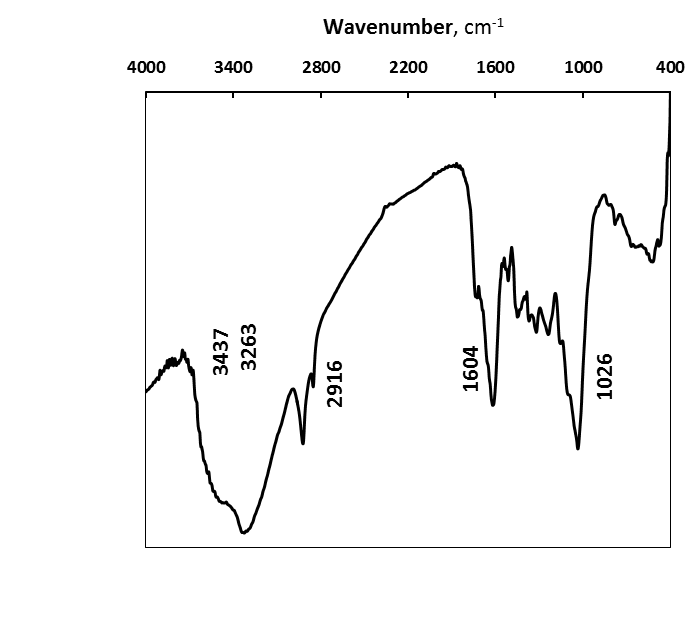 | Figure 8. FT-IR of spectra of C. siliqua bark after biosorption of metals |
4. Conclusions
- Biosorption by C. siliqua bark is a safe, ecofriendly and effective method for the removal of Ni(II), Zn(II), Cu(II), Cd(II) ions from aqueous solutions. Biosorption process parameters like pH, initial metal ions concentration, biosorbent dose, contact time and temperature were studied. The kinetic results provided the best correlation of the experimental data of biosorption of metal ions onto C. siliqua bark by pseudo second-order equation. The biosorption isotherms could well be fitted by the Langmuir model. it can be concluded that since the C. siliqua bark is an easily, locally available, low-cost adsorbent and has a considerable high biosorption capacity, it may be treated as an alternative adsorbent for treatment of aqueous solutions containing Ni(II), Zn(II), Cu(II) and Cd(II) ions.
ACKNOWLEDGEMENTS
- Authors are thankful for Royal Scientific Society, Jordan University and Baghdad University for providing the necessary facilities to carry out this work.
References
| [1] | O. J.Esalah, M.E.Weber, J.H.Vera. Removal of lead, cadmium and zinc from aqueous solutions by precipitation with sodium di-(n-octyl) phosphinate. Can. J. Chem. Eng. 78 (2003) 948–954. |
| [2] | A.I. Zouboulis K.A. Matis B.G., Lanara, C.L., Neskovic. Removal of cadmium from dilute solutions by hydroxy apatite. II. floatation studies, Sep. Sci. Technol., 32: 1755–1767Kevin R. Fall, W. Richard Stevens, TCP/IP Illustrated, Volume 1 (1997). The Protocols, 2nd ed., Addison-Wesley, USA, 2011. |
| [3] | LM..Canet, M. Ilpide. P. Seat. Efficient facilitated transport of lead, cadmium, zinc and silver across a flat sheet- supported liquid membrane mediaed by lasalocid A, Sep. Sci. Technol. 37 (2002) 1851–1860. |
| [4] | K. Dermentiz, A. Christoforidis, E. Valsamidou, A. Loucas, K Greece. Removal of nickel, copper, zinc and chromium from synthetic and industrial wastewater by electrocoagulation. Inter. J. Environ. Sci. 1 (2011) 697-710. |
| [5] | V.J. Imglezakis, M.D. Loizidou, H.P. Grigoropoulou. Ion exchange of Pb2+, Cu2+, Fe3+, and Cr3+ on natural clinoptilolite: selectivity determination and influence on activity on metal uptake. J. Colloid and Interface Sci. 261 (2003) 49-54. |
| [6] | P. T. Bolger, D. C. Szlag. Electrochemical treatment and reuse of nickel plating rinse waters. Environ. Progress, 21 (2004) 203-208. |
| [7] | K. Dermentzis. Removal of nickel from electroplating rinse water using electrostatic shielding electrodialysis/ electrodeionization. J. Hazar. Mater. 173 (2010) 647-652. |
| [8] | M. A. Amer, F. I. Khaili, A. M. Awwad. Adsorption of lead, zinc and cadmium ions on polyphosphate-modified kaolinite clay. J. Environ. Chem. & Ecotoxicology, 2 (2010) 1-8. |
| [9] | M. N. V. Prasad, H. Freitas (2000). Removal of toxic metals solution by leaf, stem and root phytomass of Quercus ilex L (holly oak). Environ. Pollution. 110 (2000) 277-283. |
| [10] | E.-S.Z. El-Ashtoukhy, N.K. Amin, O. Abdelwahab. Removal of lead (II) and copper (II) from aqueous solution using pomegranate peel as a new adsorbent. Desalination, 223 (2008) 162–173. |
| [11] | K. Kelly-Vargas, M. Cerro-Lopez, S. Reyna-Tellez, E. R. Bandala, J. L. Sanchez-Salas.. Biosorption of heavy metals in polluted water, using different waste fruit cortex. Physics and Chemistry of the Earth. 37–39 (2012) 26–29. |
| [12] | E. Asrari, H. Tavallali, M. Mahnoosh. Removal of Zn(II) and Pb (II) ions Using Rice Husk in Food Industrial Wastewater. J. Appl. Sci. Environ. Manage. 14 (2010) 159 – 162. |
| [13] | Q. Li, J. Zhai, W. Zhang, M. Wang, J. Zhou.. A study on adsorption of Pb(II), Cr(III) and Cu(II) from aqueous solution by peanut husk. Bull. Chem. Soc. Ethiop., 22,(2008) 19-26. |
| [14] | N. A. A. Babarinde. Kinetic, equilibrium andthermodynamic studies of the biosorption of Pb(II), Cd(II) and Cr(III) by neem leaf. Journal of Innovative Research in Engineering and Sciences 2 (2011) 291-306. |
| [15] | T. N. Gamze, B. Mesci. Adsorption of copper(II) and Zn(II) ions by various agricultural by-products experimental studies and modeling. Environ. Protection Eng. 37 (2011) 143-161. |
| [16] | M. R. Sangi, A. Shahmoradi, J. Zolgharnein, G. H. Azimi, M. Ghorbandoost. Removal and recovery of heavy metals from aqueous solution using Ulmus carpinifolia and Fraxinus excelsior tree leaves. J. Hazard. Mater. 155 (2008) 513-522. |
| [17] | A. Almasi, M. Omidi, M. Khodadadian, R. Khamutian, M.B. Gholivand. Lead(II) and cadmium(II) removal from aqueous solution using processed walnut shell: Kinetic and equilibrium study. Toxicol. Environ. Chem., 94 (2012) 660-671. |
| [18] | F.W. Sousa, M.J. Sousa, R.N. Isadora I.R. N. Oliveira, A.G. Oliveira, R.M. Cavalcante, P.B.A. Fechine, V.O.S. Neto, D. de Keukeleire, R.F. Nascimento. Evalution of a low-cost adsorbent for removal of toxic metal ions from wastewater of an electroplating factory. J. Environ.Manag. 90 (2009) 3340-3344. |
| [19] | M. Kazemipour, M, Ansari, S. Tajrobehkar, M. Majdz, H.R.Kermani. Removal of lead, cadmium, zinc and copper from industrial carbon developed from walnut, hazelnut, almond, pistachio and apricot stone. J. Hazard. Mater. 150 (2008) 322-327. |
| [20] | D.L.Mitic-Stojanovic, A., Zarubica, M. Purenovic, D. Bojic, T.Andjelkovic, A.L. Bojic. Biosorptive removal of Pb2+, Cd2+ and Zn2+ ions from water by Lagenaria vulgaris shell. Water SA, 37 (2011) 303-312. |
| [21] | A. M. Awwad, A. M. Farhan. Equilibrium, kinetic and thermodynamics of biosorption of lead(II), copper(II) and cadmium(II) ions from aqueous solutions onto olive leaves powder. Amer. J. Chem. 2 (2012) 238-244. |
| [22] | A. M. Awwad, N. M. Salem. Biosorption of copper(II) and lead(II) ions from aqueous solutions by modified loquat (Eriobotrya japonica) leaves (MLL). J. Chem. Eng. Mater Sci., 3 (2012) 7-17. |
| [23] | M. Martinez,. S. Miralles, N. Hidalgo, N. Foil N, I. Villaescusa, J. Poch. Removal of lead(II) and cadmium(II) from aqueous solution by grape stalk waste. J. Hazard. Mater. 133 (2006) 203-211. |
| [24] | H. Ucun, O. Aksakal, E. Yildiz. Copper)II) and Zn(II) biosorption on Pinus sylvestris L. J. Hazard. Mater. 161 (2009) 1040-1045. |
| [25] | V. Mishra, C. Balomajumder, V. K. Agarwa. Biosorption of Zn(II) onto the surface of non-living biomass: A comaarative study of adsorbent particle size and removal capacity of three different biomasses. Water, Air, and Soil Pollution., 2011 (2010) 489-500. |
| [26] | I. Langmuir.. Adsorption of gases on plain surfaces of glass, mica and platinum. J. Am. Chem. Soc., 40 (1918) 1361-1403. |
| [27] | H.M.F Freundlich, W. Hellen, W. The adsorption of Cis- and Trans-Azobenzene. J Amer Chem Soc. 61 (1939) 2228-2230. |
| [28] | A. Aharoni, M. Ungarish. Kinetics of activated chemisorption Part 2. Theoretical models. J. Chem. Soc. Faraday Trans. 73 (977) 456– 464. |
| [29] | Huston, N.D., Yang, R.T., 1997. Theoretical basis for the Dubinin-Radushkevich (D-R) adsorption isotherm equation. Adsorption, 3-189-185. |
| [30] | S. Lagergren.About the theory of so-called adsorption of soluble substances. K. Sven. Vetenskapsakad Handl. 24 (1898) 1–39. |
| [31] | M.B. Lohani, A. Singh, D.C. Rupainwar, D.N. Dhar. Studies on efficiency of guava (Psidium guajava) bark as biosorbent for removal of Hg(II) from aqueous solutions J. Hazard. Mater. , 159 (2008) 626-629. |
| [32] | M. Ajmal, R.A.K., Rao, R. Ahmad, J. Ahmad. Adsorption studies of Citrus reticulate (fruit peel orange): removal and recovery of Ni(II) from electroplating wastewater, J. Hazard. Mater., 79 (2000) 117-131. |
 Abstract
Abstract Reference
Reference Full-Text PDF
Full-Text PDF Full-Text HTML
Full-Text HTML